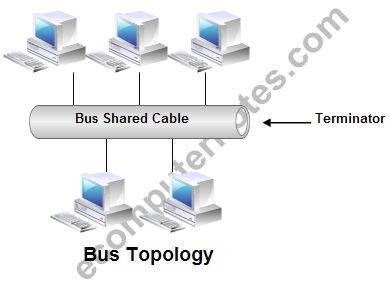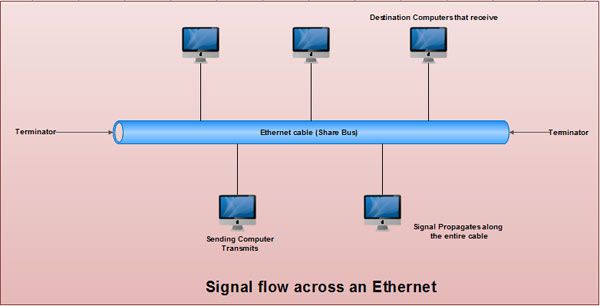Bus Topology is multipoint electrical circuits that can be implemented using coaxial cable, UTP, or STP. Data transmission is bidirectional, with the attached devices transmitting in both directions. While generally operating at a raw data rate of 10 Mbps, actual throughput is much less.
It is employed frequently in the LANs with distributed control. In all nodes, as shown in Figure, share the shared bus. Messages placed on the bus transmitted to all nodes. Nodes must be able to recognize their address to receive messages. However; unlike nodes in a ring, they do not have to repeat and forward messages intended for other nodes. As a result, there is none of the delay and overhead associated with re-transmitting messages at each intermediate node. Because of the passive role node play in transmission on the bus, network operation continues in the event of node failures. This makes distributed BUS networks inherently resistive to single-point failures. 
Bus networks employ a decentralized method of media access control known as CSMA (Carrier Sense Multiple Access), that allows the attached devices to make independent decisions relative to media access and initiation of transmission. This approach results in data collisions and requires frequent retransmission. However, networks specified in the IEEE 802.3 standard, and generally, have a maximum specified length of 1.5 miles (2.5 km). Ethernet is based on a bus topology. A tree topology is a variation on the bus topology, with multiple branches of the trunk of the central bus. Bus networks also suffer from the vulnerability of the bus, as if, one node is down, all nodes in the bus down. Similarly, tree networks are dependent on the integrity of the root bus.
We’ll be covering the following topics in this tutorial:
Examples of Bus Topology
Ethernet – Ethernet is the least expensive high-speed LAN alternative. It transmits and receives data at a speed of 10 million bits per second. Data transferred between wiring closets using either a heavy coaxial cable (thick net) or fiber optic cable. Thicknet coaxial still used for medium-long distances where medium levels of reliability are needed. Fiber goes farther and has more excellent reliability but a higher cost. To connect several workstations within the same room, a light-duty coaxial cable called thin net commonly used. These other media reflect an older view of workstation computers in a laboratory environment. The figure shows the scheme of Ethernet where a sender transmits a modulated carrier wave that propagates from the sender toward both ends of the cable.
Ethernet was first designed and installed by Xerox Corporation at its Palo Atto Research Center (PARe) in the mid-1970. In the year 1980, DEC Intel and Xerox came out with a joint specification which has become the de facto standard. Ethernet from this period is often called DIX after its corporate sponsors Digital, Intel, and Xerox. Ethernet as the most popular protocol for LAN technology.

Local Talk
LocalTalk is a LAN that employs bus topology. Apple Computer Corporation invented it for use with Apple’s PCs LocalTalk uses ordinary telephone wire with standard RJ-l1 telephone connectors, the same as used to plug in a telephone and modem. Each connector plugs into a LocalTalk transceiver, which connects to a PC’s LocalTalk interface card. LocalTalk transceivers that connect to a PC’s parallel port are also available. Multiple computers can connect in a daisy chain, like the way railroad cars connected on a train. Hub can also be used for the same purpose.
LocalTalk does have some limitations over Ethernet. For one, LocalTalk is slower than Ethernet. LocalTalk has a bandwidth of230.4 Kbits/second, while Ethernet has a bandwidth of 10MB per second. In practice, Ethernet runs about 4-to-5 times faster, than LocalTalk. Another limitation of LocalTalk is that it cannot run TCP/IP protocols directly.
LocalTalk significant advantages are that it is simple and very inexpensive. The hardware and software required for LocalTalk already built into every Macintosh computer to connect with a LocalTalk network except the iMac(tm). LocalTalk is also cheaper in terms of cabling than Ethernet. Many Macintosh computer owners use a printer cable to create a temporary network between two Macintosh Computers. There is no software to install beyond the Macintosh operating system itself and LocalTalk work with any current version of the Macintosh operating system as well as versions from several years ago. For cabling of a LocalTalk network, standard RJ-II phone cable is used which is cheaper than the cable used for Ethernet. Many printers on the market come with built-in LocalTalk support, making them easy to share on such a network.
Bus Network Terminators
The terminator is a device that supplies electrical resistance at the end of a transmission line to absorb the signals of the line, thus preventing them from bouncing and being received again by the network stations.
The best cable that can use in the bus network is the coaxial cable for that it is the safest and gives you higher speed and resistance in the network.
Features of Bus Network:
• Simplicity is the simplest and most common method used in Ethernet networks.
• A long cable acts as a backbone network that connects all devices in the network.
• Use less cable than any other topology.
• The bus topology has all its nodes connected directly to a link and has no other connection between nodes.
• Physically, each host connected to a standard cable, so they can communicate directly, although breaking the cable causes the hosts to be disconnected.
• There is no signal generation on each node or router.
• The number of devices connected to the bus affects the performance of the network.
Advantages of the Bus Network
Its main advantages are:
• Easy to install and maintain.
• It is cheaper because it requires less wiring.
• It is comfortable for a small and temporary network.
• Easy to add a computer to the network.
• Internet and electricity cables can go together.
• There are no central elements on which the entire network depends, whose failure would render all stations inoperative.
Disadvantages of the Bus Network
• It is known as passive topology because computers do not regenerate the signal.
• Lose signal over distance (you can use repeaters).
• Its main drawback is that if the cable breaks at some point, the network is entirely inoperative. When it decided to install such a network in a building with several floors, what do is to install a network per floor and then join them all through a trunk bus.
• It requires much maintenance.
• The speed in this network connection is deficient.
• Equipment limit depending on the signal quality.
• Performance decreases as the network grows.
• High transmission losses due to collisions between messages.
• Takes much space.
• One information sent at a time.
Functionality of Bus Network:
• The type of wiring used can be coaxial, twisted pair, or optical fiber.
• The information travels through the cable in both directions at an approximate speed of 10/100 Mbps or has resistance at its two ends (terminator).
• Network data sent in the form of electronic signals to all computers in the network. Only one computer at a time can send messages in this topology.
• Computers connected to a bus, or transmit data to other computers on the network or expect to receive data from other computers.
• The bus topology is not responsible for transmitting data from one computer to another. Consequently, if a computer fails, it does not affect the rest of the network.
• To prevent the signal from bouncing throughout the cable, a terminator is placed on each end of the cable to absorb all the signals. It allows the cable to be released from these signals so that other computers can send data.
Ways to expand the cable:
• Using a component called “barrel or tip” that is a connector, what it does is connect two parts of the cable, creating a longer cable.
• Using a device called “repeater” that is used to connect two cables. What this device does is increase the signal to reach its destination.
 Dinesh Thakur holds an B.C.A, MCDBA, MCSD certifications. Dinesh authors the hugely popular
Dinesh Thakur holds an B.C.A, MCDBA, MCSD certifications. Dinesh authors the hugely popular